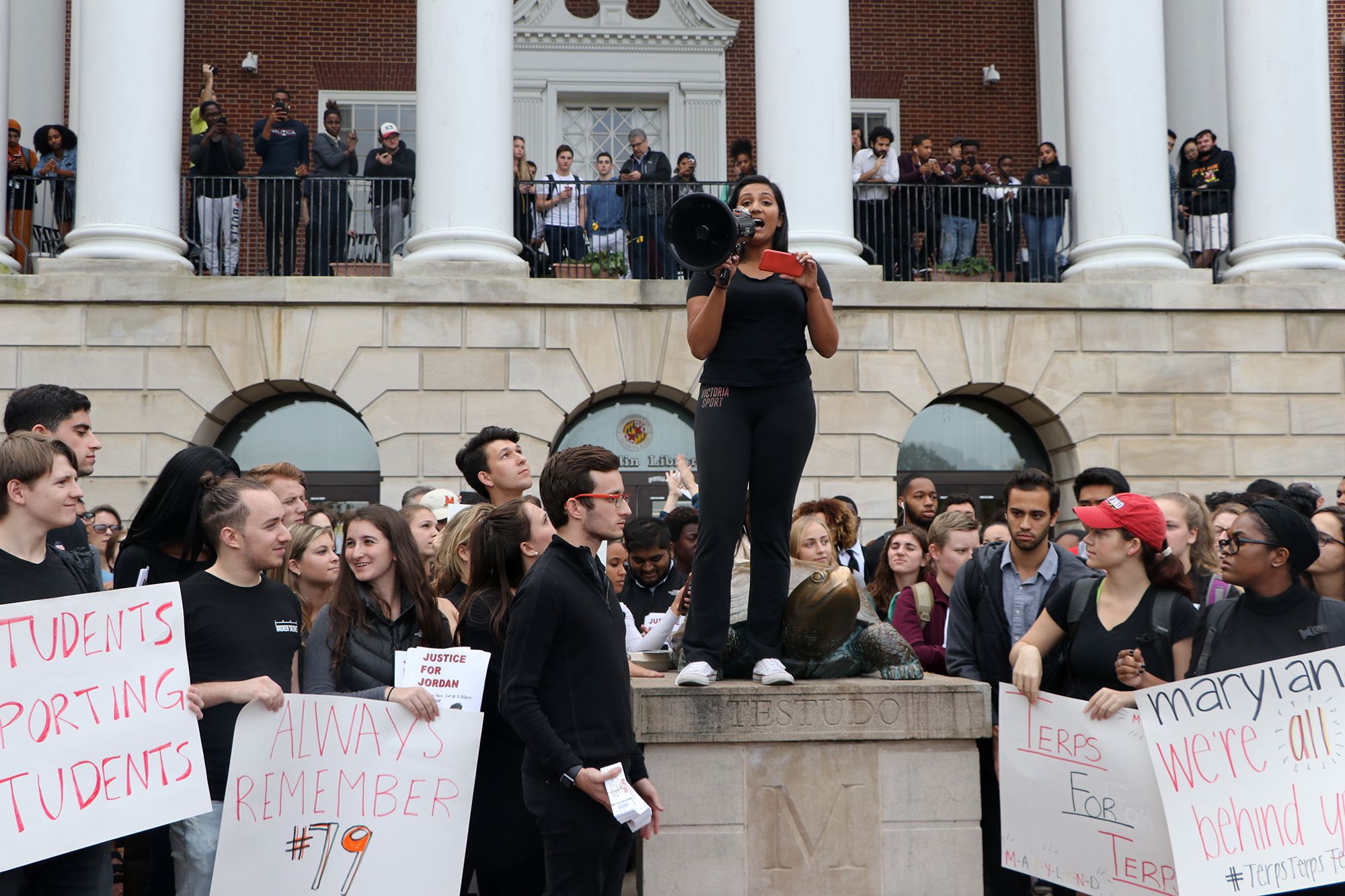With dining hall boycotts, anti-war protests and demands to cancel classes on the day of Martin Luther King Jr’s assassination, students at the University of Maryland in 1968 stood up for causes they believed in. They frequently marched across campus to demand the attention of the administration.
Fifty years later, following the death of Maryland football player Jordan McNair, students at this university have begun to organize in the same way as their predecessors, said David Andrews, a kinesiology professor.
“I hate to say this, but I always felt the campus was quite disengaged politically,” Andrews said. “This seemed to be a moment that catalyzed the student body around a particularly important issue. I think that shows something positive for the future.”
On Nov. 1, hundreds of students gathered outside McKeldin Library for the “Justice for Jordan” rally to remember McNair, who died in June after suffering heatstroke at a team workout.
After the Board of Regents recommended that head coach DJ Durkin and athletic director Damon Evans be retained, and university President Wallace Loh announced his retirement, students organized a protest against the board’s recommendations. Once Loh fired Durkin on Oct. 31, the protest became a rally in support of student-athletes, where students clashed over whether to boycott the team.
“The student response to the whole issue as this tragic event unfolded was very heartening,” Andrews said.
At a University Libraries forum called “You Say You Want a Revolution? 1968 and Its legacies,” Andrews and five other panelists discussed political, technological and athletic protests in the late 1960s.
Katarina Keane, executive director of the Center for Global Migration Studies at this university, spoke about how protests began to crop up worldwide in 1968.
Although there’s no evidence that these protests were actively linked to each other, people were reading the same philosophic literature, such as “The Wretched of the Earth” by Frantz Fanon, which “theorized the ways that violence could be used in struggles for independence,” Keane said. Revolutionary leaders in countries such as South Africa, Cuba, Iran and the United States interpreted them within their own national contexts.
College students, in particular, often initiated protests. They showed a strong will to change their culture, Keane said.
“In all places around the world, we started seeing these conversations about education and about culture. These students … they see the university as a microcosm for all of these ills in their society,” she said. “The experience in the university teaches students, in a way, about their society and then they bring that struggle out into the streets.”
This university was no different, as many protests occurred on the campus in 1968, said Anne Turkos, this university’s archivist emerita. One controversy that sparked backlash arose when four black students at this university weren’t allowed to participate in a Home Economics experiment because they were “too biologically different from whites,” Turkos said.
According to Turkos, black students made up 1.8 percent of the roughly 26,000 undergraduate student population in 1968, about 20 years after black students were permitted to enroll at this university for the first time.
African-American students represent 11.6 percent of the school’s undergraduate student population in fall 2018, according to the Office of Institutional Research, Planning and Assessment. It’s the second consecutive year the percentage has dropped.
Andrews said the country is not in a “post-racial America” as some commentators claim, noting that black people continue to be disproportionately poor, undereducated, underemployed and incarcerated in comparison to other Americans.
He drew comparisons between Tommie Smith and John Carlos raising their black-gloved fists in silent protest of racism and discrimination at the 1968 Mexico City Summer Olympics, and former 49ers quarterback Colin Kaepernick kneeling during the national anthem in 2016 to protest police brutality.
“I think the parallels with this kind of symbolic act and Carlos and Smith, are clear,” said Andrews. “There’s clear homage Kaepernick pays to both and recognizing the lineage of this form of athlete activism.”
Turkos described 1968 as the “relative calm before the storm” because student protests on campus didn’t peak until the early 1970s with anti-Vietnam war demonstrations. The National Guard was called several times during this period, she said.
Emily Fox, a freshman public policy major who attended the forum, said students now have a different attitude toward war.
“I think that student movements against [President Donald] Trump draw a parallel,” Fox said. “But one major difference that I see is the disengagement of students/young people with the actions of the U.S. military. In 1968, there was a draft, which caused people to think a lot more critically about the U.S. military’s actions in Vietnam. But now, we’ve been at war for 17 years and we see nowhere near that amount of engagement.”
The 1968 protests are described as “both transformational and huge failures,” according to Keane. She said almost every single one of those protests failed.
“But when you step back it looks a little bit different,” she said. “The spirit of 1968 seems [to show] that these kind of deeper changes were happening all around the world, in personal relationships, in culture, in the way people thought of themselves and the way that it gave people a voice who didn’t have one before.”



